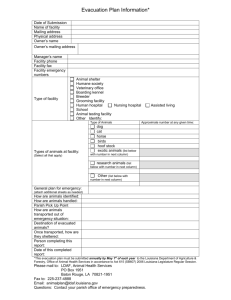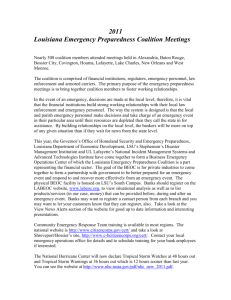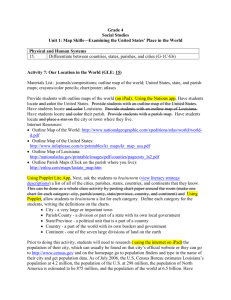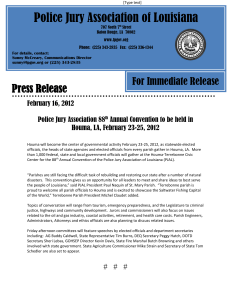2015 Emergency Preparedness Meeting Notes
advertisement
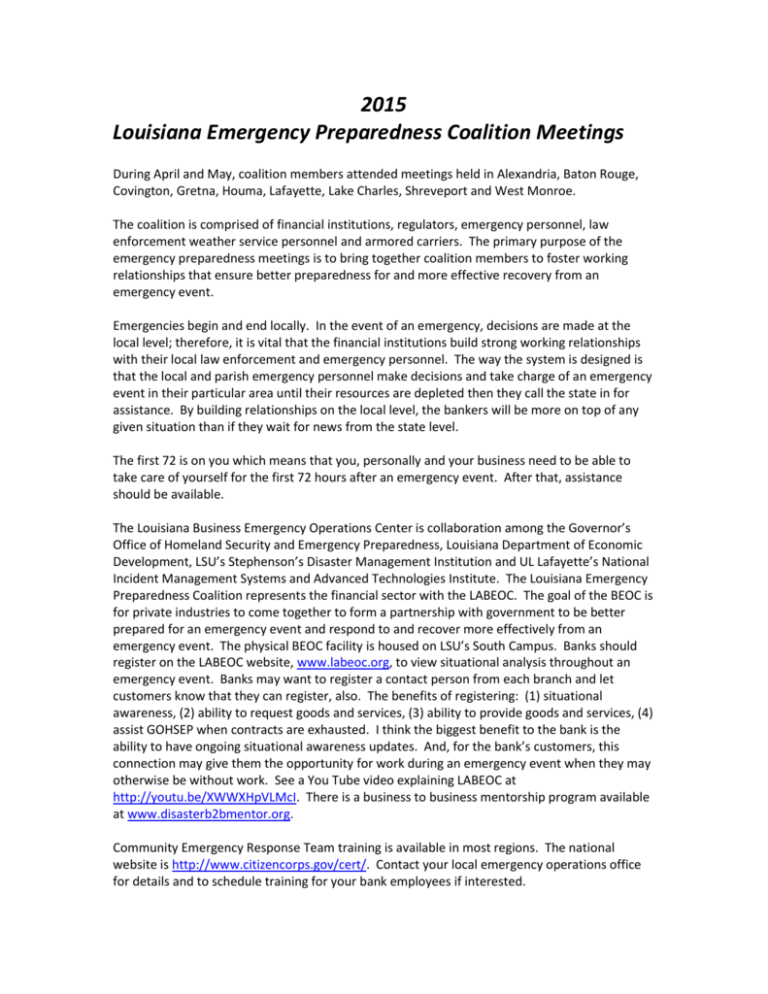
2015 Louisiana Emergency Preparedness Coalition Meetings During April and May, coalition members attended meetings held in Alexandria, Baton Rouge, Covington, Gretna, Houma, Lafayette, Lake Charles, Shreveport and West Monroe. The coalition is comprised of financial institutions, regulators, emergency personnel, law enforcement weather service personnel and armored carriers. The primary purpose of the emergency preparedness meetings is to bring together coalition members to foster working relationships that ensure better preparedness for and more effective recovery from an emergency event. Emergencies begin and end locally. In the event of an emergency, decisions are made at the local level; therefore, it is vital that the financial institutions build strong working relationships with their local law enforcement and emergency personnel. The way the system is designed is that the local and parish emergency personnel make decisions and take charge of an emergency event in their particular area until their resources are depleted then they call the state in for assistance. By building relationships on the local level, the bankers will be more on top of any given situation than if they wait for news from the state level. The first 72 is on you which means that you, personally and your business need to be able to take care of yourself for the first 72 hours after an emergency event. After that, assistance should be available. The Louisiana Business Emergency Operations Center is collaboration among the Governor’s Office of Homeland Security and Emergency Preparedness, Louisiana Department of Economic Development, LSU’s Stephenson’s Disaster Management Institution and UL Lafayette’s National Incident Management Systems and Advanced Technologies Institute. The Louisiana Emergency Preparedness Coalition represents the financial sector with the LABEOC. The goal of the BEOC is for private industries to come together to form a partnership with government to be better prepared for an emergency event and respond to and recover more effectively from an emergency event. The physical BEOC facility is housed on LSU’s South Campus. Banks should register on the LABEOC website, www.labeoc.org, to view situational analysis throughout an emergency event. Banks may want to register a contact person from each branch and let customers know that they can register, also. The benefits of registering: (1) situational awareness, (2) ability to request goods and services, (3) ability to provide goods and services, (4) assist GOHSEP when contracts are exhausted. I think the biggest benefit to the bank is the ability to have ongoing situational awareness updates. And, for the bank’s customers, this connection may give them the opportunity for work during an emergency event when they may otherwise be without work. See a You Tube video explaining LABEOC at http://youtu.be/XWWXHpVLMcI. There is a business to business mentorship program available at www.disasterb2bmentor.org. Community Emergency Response Team training is available in most regions. The national website is http://www.citizencorps.gov/cert/. Contact your local emergency operations office for details and to schedule training for your bank employees if interested. Financial Institutions are encouraged to talk with their customers about emergency preparedness. The Red Cross has several mobile apps that you may be interested in, http://www.redcross.org/prepare/mobile-apps. Red Cross is available to do outreach presentations to groups and companies. They encourage you to like their face book page. Also, they remind you to have a hard copy of contact information. One bank uses Voicenation for phone message service, 866-766-5050, www.voicenation.com. Cybersecurity resources o o o o o o o o o o o o o Cybersecurity 101: A Resource Guide for Bank Executives, http://www.csbs.org/CyberSecurity/Documents/CSBS%20Cybersecurity%20101 %20Resource%20Guide%20FINAL.pdf FFIEC Cybersecurity Awareness, https://www.ffiec.gov/cybersecurity.htm FDIC: Cyber Challenge: A Community Bank Cyber Exercise, https://www.fdic.gov/regulations/resources/director/technical/cyber/p urpose.html Webinar on Senior Management’s Role in Cybersecurity, https://www.fdic.gov/news/news/financial/2014/fil14021.html OCC Cybersecurity Assessment General Observations and Statement, http://www.occ.gov/news-issuances/bulletins/2014/bulletin-2014-53.html ABA Cyber and Mobile Security, http://www.aba.com/Issues/CyberSecurity/Pages/default.aspx ICBA Cyber & Data Security Resources, http://www.icba.org/publications/visa.cfm?ItemNumber=37529 Boards Need Cybersecurity Training Webinar Recording, http://www.lba.org/productdetail.cfm?EID=WEBREC2615 Financial Services Information Sharing and Analysis Center, https://www.fsisac.com/ Homeland Security Information Network, http://www.dhs.gov/homelandsecurity-information-network-hsin Homeland Security, http://www.dhs.gov/stopthinkconnect DDoS, https://www.us-cert.gov/ncas/tips/ST04-015 Can be added to the Louisiana Fusion Center email bulletin list by emailing Ric Moore at buren.moore@la.gov or calling 225-925-3674 or 225-936-0404 NIST Cybersecurity Framework, http://www.nist.gov/cyberframework/ Information learned: FDIC Lessons Learned from Hurricane Katrina information booklets available at http://www.ffiec.gov/katrina.htm. The following Financial Institution Letters may be helpful to your emergency planning: o FIL88-2005, http://www.fdic.gov/news/news/financial/2005/fil8805.html o FIL89-2005, http://www.fdic.gov/news/news/financial/2005/fil8905.html o FIL91-2005, http://www.fdic.gov/news/news/financial/2005/fil9105.html Financial Services Sector Coordinating Council, www.fsscc.org, can be used to find emergency plans. FDIC gets emergency contact information from the financial institution’s call report; therefore, make sure that information is accurate and updated. FDIC will list open and closed branches during an emergency event on FDIC website, www.fdic.gov; FDIC will gather this and other information by calling, with assistance from other regulators, each bank in the affected area, therefore, updated contact information is crucial. The regulators will ask a list of questions of the bank after an emergency event. A copy of the questions is attached to these notes. FDICconnect may be a good communications tool. Banks can access this through the FDIC website at https://www2.fdicconnect.gov/index.asp. FDIC will host daily conference calls with all regulators, state banking association and bankers during an emergency event. 1-877-ASK-FDIC is the toll free number for bankers and consumers to call requesting information during an emergency event. FDIC encourages use of GETS card for priority telephone line usage, TSP for priority restoration of phone and WSP for wireless service for a fee, http://transition.fcc.gov/pshs/services/priority-services/gets.html , http://transition.fcc.gov/pshs/services/priority-services/tsp.html and http://transition.fcc.gov/pshs/services/priority-services/wps.html. We understand that GETS will work for voice over IP phone systems as well as land lines. Set up alternative ways to communicate with your employees such as text, satellite phones, Yahoo groups, etc. Make sure emergency plans are fully tested, complete back up testing, annually. Every aspect needs to be tested, including physical, liquidity borrowings and actual core back up. If you have to open a temporary location to take deposits after an emergency, notify the FDIC within three (3) days and file an application within ten (10) days – the application can be an email that lists where you are, the reason for the temporary location and how long you expect to be in the temporary location. If you have a back-up site, make sure you know how many other banks will be utilizing the same site in the event of a large area emergency event. The Fall 2009 Consumer News included an article on Safe Deposit Boxes to assist consumers, and it may be helpful to include in some of your communications, http://www.fdic.gov/consumers/consumer/news/cnfall09/five_things.html. For cybersecurity, make sure you have flow charts of all work processes in and out of the bank. Contacts: o John Perez, assistant regional director, is primary contact at 972-761-2099, 303589-8777 (cell), jperez@fdic.gov o Cindy Scott, special assistant to the regional director, 972-761-2037, 972-4677742 (cell), cscott@fdic.gov o Victor Ingram, Louisiana field supervisor, 318-868-6661 x 4925, 318-230-5322 (cell), vingram@fdic.gov Federal Reserve To receive most up to date information, www.frbservices.org (put in routing number and all contact information at the Fed for your bank including contact lists for ordering money will appear) and 1-800-333-2690. You can sign up for alert notifications at this website, also. See FedCash Services Business Continuity Guide at http://www.frbservices.org/businesscontinuity/cash_services.html. Jack Bonin, Federal Reserve Bank of Atlanta, New Orleans Branch, 504-593-3308. National Sales Support Team, 800-257-6701. www.frbatlanta.org and www.dallasfed.org are regional sites with emergency information. Key contacts for FRB Memphis Cash Operations, http://www.stlouisfed.org/memphis/, which is where cash for North Louisiana is shipped from: o Lisa Jones – Cash Manager, 901-531-5037 (o), Lisa.d.jones@stls.frb.org o DeMarcus Butts – Administration Supervisor, 901-531-5021 (o), demarcus.j.butts@stls.frb.org o Joey Gambino – Assistant Vice President, 901-531-5004 (o), joey.gambino@stls.frb.org o Memphis Cash Operations, 1-800-552-5132 ext. 531-5114, 901-531-5031 (fax) o Memphis Cash Conference Bridge, 1-855-377-2663, participant code 49049300 Encouraged banks to look into the Association of Contingency Planners, http://www.acp-international.com/, for resources. Important to keep Fed Line updated. It would be good to have a mutually agreed upon buddy bank with an agreement to be able to work through the buddy bank’s channels when necessary. In an emergency event, if all other avenues are interrupted, banks will be allowed to order coin and currency by phone as long as the Federal Reserve has record of your contact information on hand – limit number of contacts and make sure the contacts have authorization capability. Update Official Authorization Lists in order to have the appropriate people on file to order more money than usual if needed by calling your contact at the Fed. For the New Orleans Fed office, call Joy Tregre, Pete Dupart or Dean Woitha at 504-593-3226 or 3227. Fax main money handlers to Joy Tregre at 504-593-3218. Federal Reserve Emergency Notification Services/Internet, FRENSi -- all banks in the state are eligible and must register to be notified of emergency situations – sign up at frbatlanta.org/forms/banking/frensi.aspx or emailing frensi@atl.frb.org or by calling 404498-8870. Strategic Inventory Locations, SILs – banks must register and be approved to hold cash in bank vault that remains on the Federal Reserve’s books until an emergency happens then money will be transferred to the bank for the bank’s use and distribution – contact your Federal Reserve representative to apply for a SIL in your bank. There are security requirements to be eligible for a SIL. When an emergency is approaching, the Federal Reserve begins packaging money in bales with 16 bundles of $20s. One bale is $320,000. If you order in 16 bundle denominations, for any denomination, the orders will be processed faster. Make only critical orders during an emergency event, and consider keeping extra money on hand during emergency event seasons. There is an increase in counterfeit currency during and after an emergency event; therefore, make sure your employees are on notice. If there is a declared emergency in your parish, the bank can defer ACH by 2:00 pm CST to the next available processing day. You need to notify the Fed and the bank’s CFO. If there is no declared emergency and the bank needs to defer ACH, please contact your account executive. Also contact your account executive if you are moving locations so that you can set up settlements, ACH, wires, etc. and set up how files will be processed post event. Banks can set up a contingency arrangement for Check 21 in the event that a bank’s upstream correspondent has problems. Contact your Fed Account Representative to set this up. Make sure someone is maintaining Fed balancing procedures and reconcilement to ensure everything is in order during and after an emergency event. Banks must be in touch with armored carriers before, during and after an emergency – the Federal Reserve does not have any money carriers nor do they contract with any – the contract is between the bank and the carrier. If you change the hours at your locations or only open certain locations, notify the armored carrier and the Fed. Someone in your bank needs to be responsible for watching the weather to make sure where an event may occur and timing of the event. The Federal Reserve is responsible for contaminated currency and will accept returned contaminated currency under proper procedures. The US Mint is responsible for coins and The Fed will not accept the return of contaminated coin. Follow the Federal Reserve on Twitter – St. Louis FRB: @stlouisfed, Atlanta FRB: @AtlantaFed, New Orleans FRB: @FRBNewOrleans Whenever there are insurance checks coming in after emergency events, make sure you are checking endorsements and following your proper identification procedures. OCC New Orleans Field Office: New Orleans ADC: New Orleans ADC Analyst: david.clay@occ.treas.gov everett.tolbird@occ.treas.gov Office 504-434-3970 Cell 228-424-6284 Cell 202-417-0835 Longview ADC: terry.richter@occ.treas.gov Office 903-759-3800 Southern District Office: Dallas, AsDC: janice.mcquary@occ.treas.gov Dallas, AsDC Analyst: yessica.sosa@occ.treas.gov Dallas, Acting ADC, Spec/Ops: sean.shanahan@occ.treas.gov Dallas Deputy Comptroller: gil.barker@occ.treas.gov Washington DC, Senior Advisor: beverly.cole@occ.treas.gov Office Office Office Cell Office Office 214-720-0656 214-720-7029 214-720-2829 202-664-7854 214-720-7005 202-649-6862 During an emergency, banks may also obtain the most current information from our office by accessing Banknet at www.banknet.gov. 2012-28 OCC Bulletin, Supervisory Guidance on Natural Disasters and Other Emergency Conditions, http://www.occ.gov/news-issuances/bulletins/2012/bulletin-2012-28.html Make sure vendors have business continuity plans and that they are being tested. OFI Collecting Disaster Recovery Team contact information now. Email primary and secondary contact information to Donna Montagnino, dmontagnino@ofi.la.gov. www.ofi.louisiana.gov information updated in the event of an emergency. When emailing to OFI pre, during and post emergency event use ofila@ofi.la.gov because multiple people have access to that email account – use to notify of status and use this email address to notify OFI if you have to close a location or open a temporary location – need to notify OFI of a branch relocation within three (3) days. Need to notify OFI of any adjustments to normal operations such as change of hours and/or location. OFI has set up an automatic reply from this email address so that you have proof of your notification. If a Louisiana state chartered bank has branches outside of Louisiana that they need to close, notify OFI, and they will notify the other state regulators. Encourage banks to put signs in closed locations letting customers know what other locations are available. Financial Institutions should “really” test their disaster recovery plans to make sure you can actually run your work if you have to go to your back up plan. Now looking at cybersecurity in exams. Want to see board and management training as well as customer training. There are several resources for cybersecurity on OFI’s website, www.ofi.state.la.us, click on Banks to see resources. Call any regional office if you cannot get in touch with Baton Rouge office: Supplemental OFI Contact Information: OFC. NO. John Ducrest, Commissioner 225/922-2627 Christine Kirkland, Deputy Commissioner 225/922-0632 Sid Seymour, Chief Examiner 225/925-4675 John Fields, Deputy Chief Examiner 225/922-0633 Tim Robichaux, Deputy Chief Examiner 225/922-0878 George Clancy, Alexandria District Office Manager 318/487-5023 Barry Ensminger, Baton Rouge District Office Mgr 225/922-0368 Neil Ponthie, Lafayette District Office Manager 337/262-5754 Janet Gibson, Monroe Assistant District Office Mgr 318/362-5292 Mark Wall, New Orleans District Office Manager 504/568-8536 Onjel Ingram, Shreveport District Office Manager 318/862-9706 CELL NO. EMAIL ADDRESS 225/938-2009 225/287-9603 225/747-0718 225/747-0723 225/747-0722 225/747-0725 225/747-0724 225/747-0726 225/747-0727 225/747-0728 225/747-0729 jducrest@ofi.la.gov ckirkland@ofi.la.gov sseymour@ofi.la.gov jfields@ofi.la.gov trobichaux@ofi.la.gov gclancy@ofi.la.gov bensminger@ofi.la.gov nponthie@ofi.la.gov jgibson@ofi.la.gov mwall@ofi.la.gov oingram@ofi.la.gov Louisiana State Police www.lsp.org and *LSP on your cell phone to get up to date emergency information. Local Red Cross offices have regional evacuation route maps available for distribution – to find your local Red Cross office, http://www.redcross.org/where/chapts.asp. The state police have a Statewide Credentialing Access Program which can be found at http://www.lsp.org/pdf/lscap.pdf -- this program recommends a re-entry procedure for local municipalities to use; however, each parish can choose to strengthen the re-entry requirements – at a minimum, bankers should have the state police re-entry letter in their vehicle, stating their reason to enter the area. Banks are encouraged to contact their local emergency preparedness office, http://www.gohsep.la.gov/parishoepnumbers.aspx, to build a relationship with the emergency personnel and to understand how evacuations and re-entries will work – Contact the parish emergency official to secure re-entry credentialing where your branches are located. Because of the limited number of state policemen and their responsibilities with evacuation, contraflow and shelters, it is highly encouraged that banks work with local partners in law enforcement and emergency preparedness first. Banks will need to have their own security for re-entry. Before financial institutions can re-enter after an emergency event, major routes must be intact and passable, there is no threat to public safety, and, search and rescue operations are completed. To get information about road conditions, dial #511 or http://www.511la.org/, for Louisiana Department of Transportation and Development and dial *LSP or http://www.lsp.org/roadclosure.html for Louisiana State Police. LDOTD makes the final call on closing major arteries. You can sign up for MyDOTD, http://wwwapps.dotd.la.gov/administration/announcements/mydotd.aspx, to stay connected with DOTD and up-to-date on local projects, land and road closures and other DOTD activity. Arkansas State Police also have a link for road status, http://www.arkansashighways.com/. Please contact Kelli Polk if you have any questions about the Homeland Security Information Network (HSIN): Kelli Polk Investigative Specialist II Louisiana State Analytical and Fusion Exchange Louisiana State Police 376A East Airport Dr. Ph. 225-925-6222 Fax. 225-925-4766 email: kelli.polk@dps.la.gov Governor’s Office of Homeland Security and Emergency Preparedness Parish Homeland Security & Emergency Contacts: http://gohsep.la.gov/parishoepnumbers.aspx – some parishes have face book and twitter links along with contact information. Like and follow the parishes that are most important to you. If you do not see links here, search for the parish in face book and on twitter as some are not listed here yet. Important websites, http://gohsep.la.gov/, www.fema.gov, www.ready.gov, www.getagameplan.org, www.emergency.la.gov You can get a Get a Game Plan App and a Get a Business Plan App for iPhone and iPad from the Apple iTunes Store Louisiana Emergency Preparedness Association, www.lepa.org, as a resource Encourage National Incident Management System courses for emergency preparedness personnel through http://www.fema.gov/national-incident-management-system FEMA hurricane information, http://www.ready.gov/hurricanes FEMA Region 6, http://www.fema.gov/region-vi www.cdc.gov for pandemic information and http://new.dhh.louisiana.gov/index.cfm/subhome/17/n/173 for Louisiana Department of Health and Hospitals concerning emergency preparedness Virtual Louisiana is a google mapping software used by the state. You can register to have access by sending an email to laearth@la.gov or by clicking on Request and Account at http://www.virtualla.la.gov/site/. To be included on the cyber security email distribution list, email a request to Kevin Breaux at kevin.breaux@la.gov. National Weather Service Forecast cone get smaller each year with better forecasts Expect storms to hit outside cone 1/3 of the time; although, forecasting in the Gulf is better results than that. Cone only tells where center of storm will travel. Introduced in 2014 – potential storm surge inundation graphic o Shows storm surge risk – reasonable worst case scenario based on current advisories o Will not forecast water levels such as topping levees. o Experimental storm surge watch/warning, http://www.nhc.noaa.gov/gtwo_epac.shtm Highlights areas where life threatening storm surges may be; watches at 48 hours, warnings at 36 hours www.weather.gov/neworleans & NWSNewOrleans on face book and twitter The National Weather Service, http://www.weather.gov/. The tropical outlook will show yellow for low probabilities, orange for moderate and red for high. For weather briefings, go to http://www.srh.noaa.gov/lix/?n=embrief2. To join New Orleans/Baton Rouge briefings, email Danielle.manning@noaa.gov. For mobile emergency response tool, go to http://innovation.srh.noaa.gov/ertool/, click on EMA then click on Briefings. 24-hour access, 985-649-0429 x 4 and 504-522-7330 x 4 Louisiana’s Homeland Security & Emergency Management Regions: See Regions and Regional Directors and Coordinators at http://www.gohsep.la.gov/regions.aspx. 1. Orleans, St. Bernard, Plaquemines, Jefferson – Darryl Delatte, Coordinator, darryl.delatte@la.gov, 225-485-7452 – can apply http://reentry.nola.gov/ for regional re-entry placard. Jefferson Parish EOC number 504-349-5360, and, www.jumpstartjefferson.com to apply for Tier 2 placards – you can get as many as you need. Employees are encouraged to have a letter on bank letterhead explaining who has what placard and what they are doing – the employee should have a picture ID, also. Special needs citizens need to register with Jefferson Parish. You need to get updated placards every two years. You should apply in the parish where home your base is. You can apply for a regional placard that covers Orleans, St. Bernard, Plaquemines, Jefferson and St. Tammany. Private companies selling placards – will not be recognized. Contraflow begins at 30 hours; airport closes at 12 hours; first responders shelter in place at six hours. Get NOLA Ready, http://www.nola.gov/ready/. NOLA contact, Dev Jani, ddjani@nola.gov. Register for Jefferson Parish Alert at https://member.everbridge.net/index/892807736721515#/login. Jefferson Parish will start evacuation at H-54 hours. Jefferson Parish contact, Charlie Hudson, 504-349-5360, chudson@jeffparish.net. Plaquemines Parish contact, Guy Laigast, 504-274-2476, guy@plaqueminesparish.com. St. Charles Parish contact, Ron Perry, 985-783-5050, rperry@stcharlesgov.net, communications@scpeoc.org. 2. East Baton Rouge, West Baton Rouge, East Feliciana, West Feliciana, Pointe Coupee, Iberville, Ascension, Livingston – Darren Guidry, Coordinator, darren.guidry@la.gov, (225) 916-4905. East Baton Rouge Parish now has a re-entry placard system that can be applied for at www.capitalareaready.com. If you have questions or issues with the placards, please contact Kellie McGaha, Emergency Preparedness Coordinator, East Baton Rouge, 225389-2100, kmcgaha@brgov.com, mohsep@brgov.com, www.redstickready.com. Fusion Center, Buren “Rick” Moore, buren.moore@la.gov, 225-936-0404 and 225-9254192; Devin King with cybersecurity and Kelli Polk with State Police 3. Assumption, St. James, St. John, St. Charles, Lafourche, Terrebonne – Pam Roussel, Coordinator, pam.roussel@la.gov, 985-851-2900. All Region 3 parishes have point to point evacuations set up instead of having to rely on the state or FEMA. Earl Eues, Terrebonne OEP Director, eeues@tpcg.org, 985-873-6357. Terrebonne’s point to point is Ouachita Parish. Terrebonne has a unified command system within the office of emergency preparedness with emergency support functions. Contact Tammy Duplantis, 985-873-6357, at Earl Eues office to sign up for the weather email list. www.tpcg.org will have streaming audio of press conferences and will have ongoing blog pre, during and post emergency event. 1-888-356-4737 is community hotline phone number. www.tohsep.com is the Terrebonne Office of Homeland Security and Emergency Preparedness. From this page, you can access the twitter and Facebook accounts. Apply for re-entry badges at http://www.parishreentry.com/terrebonne/, or 985-873-6357. Re-entry badges need to be renewed each year. When the system is activated prior to an emergency event, you will get an email to print placard. Other parishes have been asked to honor Terrebonne’s placard. Tier 2 re-entry is not allowed to bring families in with them. Bank president or designee may get Tier 1 placard for reentry to assess damage and to plan for Tier 2 entries. Terrebonne Parish calls evacuations for medical needs people at 60 hours out and for general public at 50 hours out. Lafourche Parish now has placards for reentry, http://parishreentry.com/Lafourche/index.php. Placards are event specific and will be sent out by event. Contact Chris Boudreaux, 985-532-8174, chrisb@lafourchegov.org. Placards are free. Need to register/renew each January. St. Charles Parish has an emergency notification system that you can register for at http://www.stcharlesparish-la.gov/departments/emergency-preparedness, or, call 985783-5050. St. Charles has a point to point evacuation with Tangipahoa Parish. They use the state police re-entry credentialing program. 4. Evangeline, St. Landry, Acadia, Lafayette, St. Martin, Vermilion, Iberia, St. Mary – Regional Coordinator, Lee John, lee.john111@la.gov, 225-925-7520 St. Mary Parish, Paul Naquin, Jr., 337-828-4100 x 500, pnaquin@stmaryparishla.gov. Honor other parishes’ re-entry to pass on Hwy 90; to stop in St. Mary, need placard – no cost, get once and good forever. Request on letterhead with person’s name and driver’s license number for placard. Vermilion Parish, Rebecca Broussard, Director, vpoep@cox-internet.com, 337-898-4308. IDs are good for two years, $5, need letter from the bank indicating which employees get ID. Banks can be added to an email list in Evangeline Parish at vangy911@centurytel.net. Evangeline Parish also has a Facebook page. Evangeline follows state police credentialing. Lafayette Parish encourages bankers to create a badge for those people who need to reenter that includes a picture, bank name, bank logo with a letter of access on the back that says something like: In accordance with the state of Louisiana, all hazard access Standard Operating Procedures, this notice serves as the “Letter of Access” verifying the bearer is an authorized essential responder or critical employee of (enter bank name). Lafayette Parish information at 337-291-5075. 5. Beauregard, Allen, Calcasieu, Jeff Davis, Cameron – Doug Zettlemoyer, Coordinator, doug.zettlemoyer@la.gov, 225-405-9174. Calcasieu Parish, Dick Gremillion, Director, dgremillion@cppj.net, ohsep@cppj.net, 337721-3800. Calcasieu Parish has a Special Needs Assistance Program that can be applied for by completing an application through the 911 office. Sign up for www.calcashout.com to get information about emergency events. Police Jury website is www.cppj.net. www.noaa.com – use hurricane research division on website to figure storm surge for specific locations using latitude, longitude and elevation of facility. The Lake Charles Civic Center is available for those without transportation. Calcasieu has a point to point shelter agreement with Shreveport and Calcasieu is prepared to bring their own law enforcement and security to the shelter. Calcasieu will use electronic billboards to send out information. Hwys 27, 165 and 171 are evacuation routes, and, there will be no more contraflow. Re-entry credentials same as state police plan. Calcasieu Parish can provide active shooter presentations for any company. Cameron Parish, Danny Lavergne, Director, Cameron_oep@camtel.net, 337-775-7048. Cameron’s motto is Take part, Be smart, Prepare. Keep contacts updated at parish office. 6. Sabine, Natchitoches, Winn, Grant, LaSalle, Catahoula, Concordia, Avoyelles, Rapides, Vernon – Teresa Basco, Coordinator, teresa.basco@la.gov, (225) 715-3207. Harry Foster, Director, winnohsep@winnparish.org, 318-628-1160. LaSalle Parish Director Scott Franklin, sfranklin@lasalleso.com, 318-992-2151. Local emergency officials and law enforcement want to know any deviations from normal operating hours and locations so they can be aware of activity, and, they want to know about any damages. They suggest putting a weather radio in each branch for local weather. 7. Caddo, Bossier, Webster, Claiborne, Bienville, Red River, DeSoto – Jennifer Reynolds, Coordinator, jennifer.reynolds@la.gov, 318-464-5060. John Stanley, Director, websterohsep@wildblue.net, 318-846-2454. You can join the local emergency preparedness committee through Bossier Parish Emergency Operations website, http://www.cbohsep.org/Index.aspx. Bill Parker with the National Weather Service in Shreveport does training, http://www.bossiersheriff.com/news/bossier-sheriff-bossier-city-police-form-whitecollar-crime-task-force/. Bill.Parker@noaa.gov, http://www.srh.noaa.gov/shv/. Bossier Parish White Collar Crime Task Force is working with banks and offers training, Chas Dickson with Barksdale Federal Credit Union is the financial services sector liaison with the Caddo/Bossier Emergency Operations Center. His contact information is 318549-8091(o), (318) 286-7006 (c) and chas@bfcu.org. 8. Lincoln, Union, Morehouse, West Carroll, East Carroll, Madison, Richland, Ouachita, Jackson, Caldwell, Franklin, Tensas – Joe Stewart, Coordinator, joe.stewart@la.gov or 318-323-6374 (o) and 225-405-5309 (c). Use state police credentialing and need to make contact with each parish emergency official and/or sheriff for ongoing relationship. You can download Alert FM app onto smart phone for weather alerts. 9. St. Helena, Tangipahoa, Washington, St. Tammany – Collins Simoneaux, Coordinator, collins.simoneaux@la.gov, 225-329-4261 Tommy Thiebaud, Washington parish Director, tthiebaud@wpgov.org, 985-839-0434; St. Tammany, parish director, Dexter Accardo, daccardo@stpgov.org, 985-898-2359, says the regional placard will get you through the five parishes included on the placard (Orleans, Jefferson, St. Bernard, Plaquemines and St. Tammany); however, if you need to stop and work in St. Tammany, you need to get a St. Tammany placard. Catherine Cooper, ccooper@stpgov.org, is the St. Tammany Parish contact, http://www.stpgov.org/departments/homeland-security-emergency-preparedness, (985) 898-2359. Each placard has a name assigned to it. Armored Carriers Have a go-to person at each bank to communicate special orders and make sure that person has the authority to approve emergency expenditures. Identify locations that will be stocked with cash post emergency event and notify armored carrier. Order currency in Federal Reserve standard quantities for faster delivery – coin is heavy and harder to move so it slows the delivery. Will not deliver coin immediately before or immediately after emergency event – will deliver but may be a few days later. Stock up on coin prior to emergency event season. Sealing the night drops causes the armored carriers a problem. Notify your armored carrier if you will add to or reduce cash in ATMs and/or smart safes before/after emergency event. Ask your armored carrier for a copy of their business continuity plan so that you’ll know what to expect from them in an emergency situation in case you cannot reach them. This will be a good component to your plan. Unwritten rule that armored carriers stop getting cash from the Fed at 72 hours prior to an event. The Independent Armored Carrier Organization, WWW.IACOA.com, has good resource information. Loomis’ business continuity plan overview is on their website at http://www.loomis.us/PDFs/BusinessContinuityPlanOverview.pdf. Loomis offers a Virtual Vault where they hold money at their facility for an individual bank which can be ordered and delivered from Loomis’ facility instead of having to go to the Fed to get the money. Share local information on weather, road and/or roadblock conditions with your armored carrier as soon as you know to facilitate more effective service.



